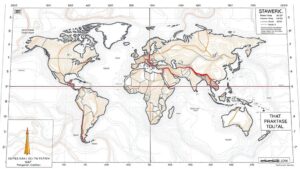Techniques for Spotting Hidden Loot in Rocky Overhangs and Shelters
Techniques for Spotting Hidden Loot in Rocky Overhangs and Shelters
The discovery of hidden loot in rocky overhangs and natural shelters has been a subject of fascination for adventurers, treasure hunters, and historians alike. These locations, often secluded and less accessible, can conceal artifacts, valuables, or remnants of past human activity. This article delves into effective techniques for identifying and locating hidden loot in these challenging environments.
Understanding the Terrain
Before embarking on any treasure-hunting expedition, it is crucial to have a thorough understanding of the terrain you are navigating. Rocky overhangs and shelters can vary dramatically in their geological formations, each with its own set of characteristics. It is advisable to analyze the landscape, taking note of factors such as:
- Geological Structure: Familiarize yourself with the type of rocks and minerals present in the area. Sedimentary rocks, for example, may harbor fossils or remnants from previous civilizations.
- Vegetation: Dense foliage may indicate the presence of moisture, which could preserve organic materials often associated with human activity.
- Topographical Features: Cliffs, slopes, and overhangs can create natural shelters where illicit items may have been hidden from view.
Employing topographical maps combined with satellite imagery can also enhance your understanding of the areas layout.
Utilizing Archaeological Methods
Applying archaeological survey techniques is valuable for spotting hidden loot in shelters. e methods rely on systematic approaches to discover artifacts. Some key methodologies include:
- Surface Surveying: Examine the ground for loose artifacts or distinct soil patterns that may indicate human activity.
- Test Excavations: Conduct exploratory diggings in areas where you suspect loot may be buried. Always follow local regulations regarding excavation.
- Stratigraphic Analysis: Study layers of sediment or earth to understand the chronological sequence of human activity in the area.
For example, an archaeological project in the southwestern United States leveraged these methods to uncover remnants of ancient dwellings hidden within rocky overhangs, leading to the discovery of pottery and tools that dated back several centuries.
Employing Technology for Enhanced Detection
Technological advancements have transformed treasure hunting in significant ways. Key technologies to consider include:
- Ground Penetrating Radar (GPR): This non-invasive method allows researchers to visualize subsurface anomalies, making it easier to locate hidden structures or artifacts without disturbing the ground.
- Metal Detectors: Specialized devices can find metallic objects buried deep within rocky substrates, increasing the likelihood of uncovering hidden valuables.
- Drones: Utilizing drones equipped with high-resolution cameras can help map areas that are difficult to access on foot, allowing for the identification of possible hideouts from above.
For example, a recent archaeological survey in the Andes employed GPR and drones to detect ancient burial sites concealed by rocky outcroppings, leading to discoveries that offered insights into pre-Columbian cultures.
Behavioral Analysis of Past Inhabitants
Understanding the behaviors and habits of those who inhabited the region can provide a framework for identifying where loot may be hidden. Some considerations include:
- Shelter Selection: Determine why certain overhangs were chosen for habitation–proximity to water sources or strategic locations may suggest they were used for living or hiding valuables.
- Cultural Practices: Research local lore and historical practices, as communities often have traditions regarding the hiding of treasures or tools in specific geographical locations.
- Patterns of Movement: Analyze how ancient inhabitants may have traveled and interacted with the landscape, as paths of trade or migration often yield clues about loot locations.
In the case of the legendary Lost Dutchmans Gold Mine, extensive research into the habits of early miners and Native Americans provided clues that led to numerous expeditions in Arizonas Superstition Mountains, highlighting the intersection of history and geography in treasure hunting.
Legal Considerations
It is essential to be mindful of legal frameworks surrounding treasure hunting. Always confirm the ownership status of land and understand local laws regarding the excavation and ownership of artifacts. In the United States, the Archaeological Resources Protection Act of 1979 sets strict regulations on the collection of artifacts from public lands, emphasizing the importance of preserving historical integrity.
Actionable Takeaways
For anyone interested in unearthing hidden loot in rocky overhangs and shelters, consider implementing the following actions:
- Conduct thorough pre-exploration research to familiarize yourself with local geology, history, and legal considerations.
- Use a combination of traditional archaeological methods and modern technology for the best chance of success.
- Pay attention to the behavioral patterns of previous inhabitants to guide your searching strategy.
With careful planning, the right tools, and respect for the land, the search for hidden loot can not only lead to exciting discoveries but also enhance our understanding of past cultures and their relationships with the environment.


